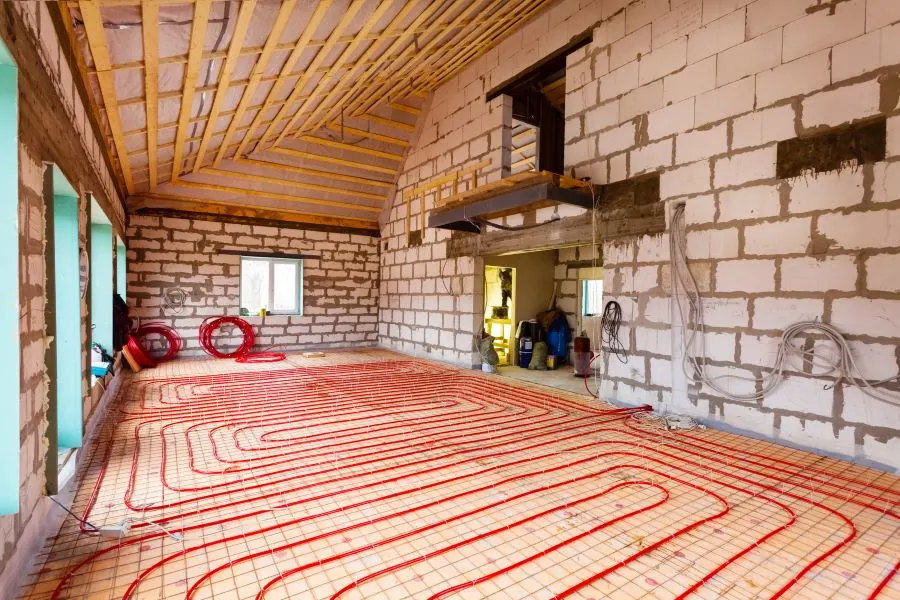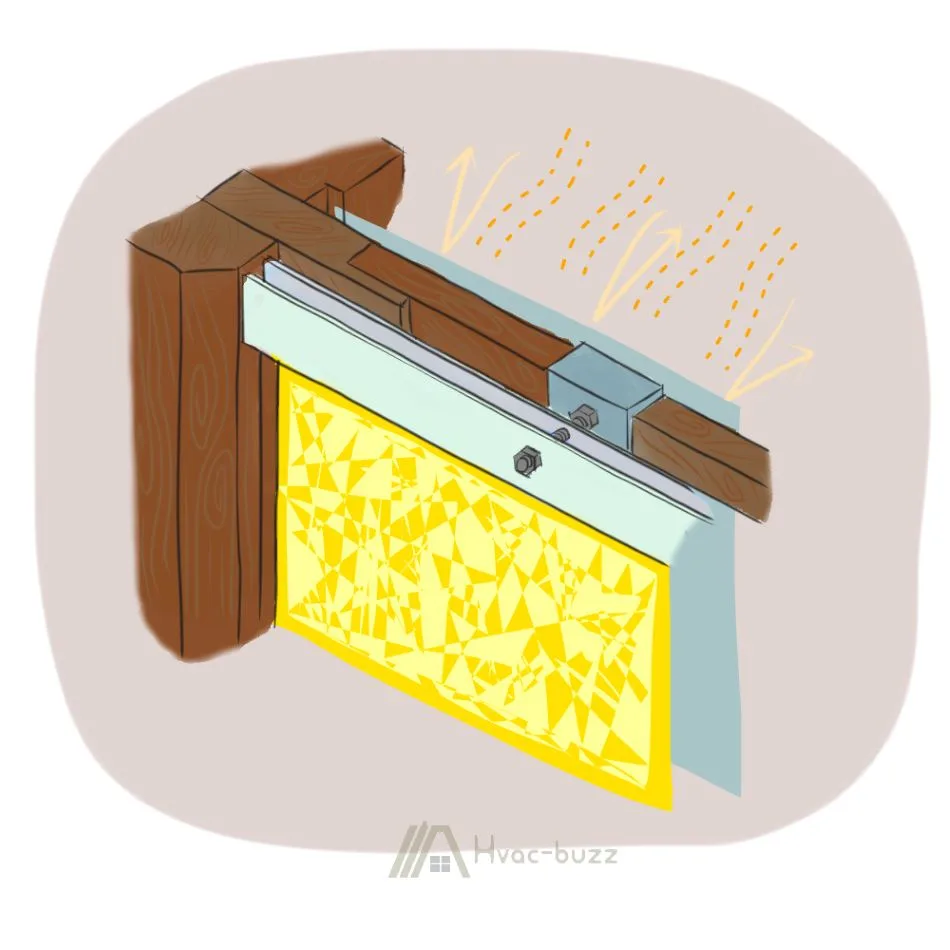A major advantage of having a walkout basement is that it is not completely underground. With it only being partially underground, it should be far less cold than the average basement. Those who have walkout basements know that they are actually still cold, although the why is not as clear.
There are many possible reasons why your walkout basement will still have chilly temperatures, but there are also some low-price and easy ways to fix it.

Hot air will always rise, so heat entering or generated in the basement naturally rises out of it. Cold air also sinks, displacing more hot air. Walkout basements are still technically underground, so cold and damp from earth can get in. Glazing can increase heat loss. Insulation is still required.
Hot Air Will Always Rise
Although it is often beneficial that hot air rises since, for the most part, the heat of your home won’t be lost to the basement if the door is open. Hot air rising also means that your basement will often be cold, this can be great in summer if your basement is a finished living space. It’s also possible to move the colder basement air up during hot summer days.
In the context of molecules, air molecules move faster and spread out more as they heat up. Their distance from each other makes hot air less dense, and therefore they rise above cooler air, which is denser.
Any heat that is generated in the basement, for example, by an electric heater, will rise to the ceiling, where it cannot be enjoyed, or even to the upper floors of the house.
Cold Air Sinks and Is Displaced by Hot Air
Due to the nature of cold air, it is more likely to dwell or collect in your basement than is hot air.
As mentioned, air becomes denser as it grows colder, following the reverse logic of hot air. Because it is denser, cold air sinks below warmer air. This acts to compound the natural rising of hot air, increasing the rate of heat loss.
Furthermore, it means that cold air doesn’t have much chance of escaping your walkout basement and, instead, will dwell near the floor where residents will feel it the most.
Walkout Basement Is Often Still Technically Below Ground
One might think that a walkout basement is free from the gripping cold of normal basements since they are not entirely underground. The truth is, though, that at least one of their walls is entirely underground, which still means that cold and damp could easily enter the basement from the earth.
Few materials are entirely impermeable to cold and damp, making contact with soil a very likely way to have moisture and cold enter through a basement wall.
Cold Entering the Basement
Soil is around 50-60°F (10-15°C) year-round at 20-30 ft (6-9 m) underground. More cold can enter in the winter if the ground freezes several feet deep. This cold then enters the basement through the walls in contact with this cold soil.
Sometimes, there seems to be an incongruity between the outside temperature and the temperature in a walkout basement, i.e., when the weather seems warmer, your basement is still in the throws of iciness and when the weather is cold, your basement feels like it is retaining heat better.
This is because of exterior insulation slowing down the rate of temperature change in response to external conditions. You can read more in my article on How Cold Will An Unheated Basement Get.
Damp Entering the Basement
The soil surrounding the walls of the basement is not only cold, but it is also a great retainer of water.
When it rains, the rainwater is absorbed into the ground and the soil becomes saturated with water. The ground stays saturated days after the rain, and this dampness enters through the basement walls in contact with it.
Another source of dampness in a basement is through high water tables. Building a basement around a water table is not possible, but building nearly on top of one is. Moisture can enter the basement through the floor in this situation.
More Glazing Means Greater Heat Loss Potential
A single glazed window only has one layer of glass. The glass is the only thing between the interior of the house and the outdoors. Since glass is certainly not an insulator, heat can escape through this single layer and cold can enter.
With every single glazed window, the possibility of heat loss grows.
Double glazing can help to slow this down, but you still have to make sure that the windows are fitted properly so that there are no cracks through which heat can escape. And, of course, if you open your walkout basement’s windows or doors, you will lose heat.
You Still Need Good Insulation
A walkout basement certainly doesn’t feel as submerged under the ground as a regular basement, but that doesn’t mean that your insulation can be lax.
Basements that are walkout still have several areas where cold and damp can make their way in, including walls that are underground, the floor, and even the windows.
Taking this into consideration, your walkout basement must still have the insulation of a normal basement. Insulation would have to be above the concrete foundation of the house, in the walls, and possibly even in the floor.

While insulation helps to control the temperature in your basement and affects the level of condensation, which can add to the cold feel of the basement, insulation cannot actually reduce basement humidity.
Easy Ways to Warm up Your Walkout Basement
Double Glazing
While single glazed windows allow heat to escape, double glazed windows are made to prevent the loss of heat.
The structure of double glazed windows includes two panes of glass instead of one, separated by space filled with a gas that has insulating properties.
These two panes and the space between them ensure that heat is kept in the living space and cold air is stopped from entering.

Sealing Windows in Winter
Double glazing is sometimes not enough, and there is also the fact that cold air might not be caused by cold panes, but rather as a result of actual air drafts coming through cracks in the window frames.
Happily, there are multiple ways to seal your windows in winter, including the ever-faithful caulk as well as shrink wrapping and weather stripping.
Space Heaters
Space heaters come in many different shapes, sizes, prices, and types. Whether you’d like an oil, infrared, or propane space heater, there are plenty of choices out there.
The advantage of a space heater is that it generates warmth to make the temperature of your walkout basement feel much different. Out of all of the quick fixes, this one will have the most noticeable effects.
- 2 in 1 heater fan: This ceramic heater provides two heat levels, 1500W or 750W and one cool air fan, you can use it both for winter and summer. Thermostat control of the heater will turn the heater...
- Multi protection safety system: These heaters are made of flame retardant material avoiding any fire hazard. Automatic safety shutoff system will shut the heater off when the heater overheat. The tip...
- Compact and powerful: 6.2 inch x 7 inch x 10.2 inch, 2.9 pounds portable mini heater with build in carry handle helps to reinforce the potential of rather low electrical bills by using at the place...
- Quiet and fast heating: The noise this ceramic heater makes is lower than 45 decibels, quiet enough for most people to use in a bedroom while sleeping. With PTC ceramic heating tech and high speed...
Last update on 2024-03-27 / Affiliate links / Images from Amazon Product Advertising API
Alternative Insulation
Materials able to insulate do not just include the insulation of your house. They also include cloth, the stuffing of pillows, and other more natural fibers of this nature.
Knowing this, rugs, pillows, tapestries on the walls, and curtains can all play a part in insulating your basement. The structures of these items trap heat, unlike metal that conducts it.
All of these decorative items are also much cheaper than making large changes to the insulation of your basement. They can also be customized greatly to decorate your walkout basement.
Dehumidifiers
A dehumidifier gets rid of moisture in the basement by taking in warm air currents through its fan and into its coils. These coils are chilled and when the warm air comes in contact with it, the condensation is left behind in the dehumidifier.
The cheapest and most straightforward plan to deal with the moisture of your basement is to purchase a dehumidifier.
- 4,500 sq ft Large Dehumidifier: Our 15.4 x 11 x 24.3 inches dehumidifier with 1.6 gallon water tank capacity removes up to 50 pints (70 Pint 2012 DOE Standard) from the air per day depending on...
- Designed For Modern Home: That most dehumidifiers are clunky eyesores is news to nobody. We designed with the modern consumer in mind: a sleek clean look, convenient built-in wheels and handles, and a...
- Super Easy To Use: Dehumidifiers don’t need to be complicated, so ours isn’t. Adjust to your ideal moisture setting, then let it run its continuous 24-hour cycle until the tank is full, at which...
- Eliminates Moisture Effectively: Our portable dehumidifier reduces moisture through its built-in pump compressor. It also features a Turbo mode that increases fan speed from Normal Air CFM 165 (cubic...
Last update on 2024-03-27 / Affiliate links / Images from Amazon Product Advertising API
If you are looking for some more solutions, you can check out my more detailed guide: Practical Ways to Warm-Up a Cold Basement.
Sources
https://www.architectmagazine.com/technology/going-underground_o
https://extension.umn.edu/moisture-and-mold-indoors/moisture-basements-causes-and-solutions
https://www.everest.co.uk/double-glazing-windows/how-does-double-glazing-work/
https://applianceanalysts.com/should-you-heat-an-unfinished-basement/
https://www.thespruce.com/use-decor-to-heat-up-your-freezing-apartment-3017413
https://www.healthline.com/health/dehumidifier-benefits#how-it-works


